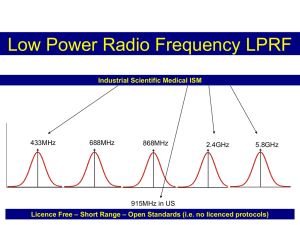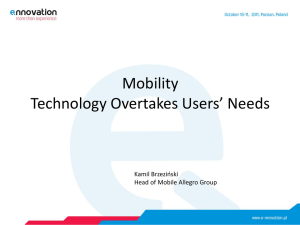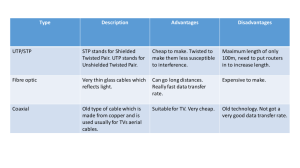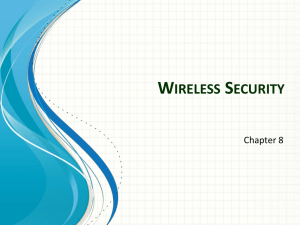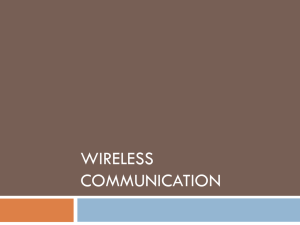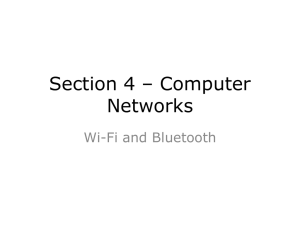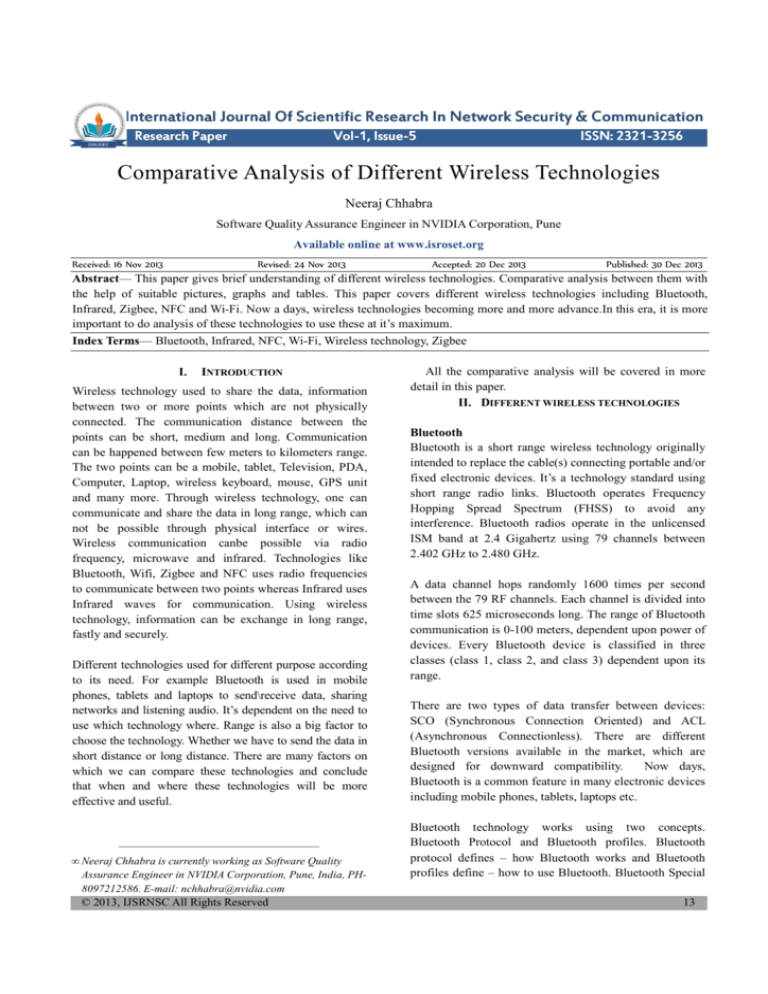
International Journal Of Scientific Research In Network Security & Communication
Research Paper
VolVol-1, IssueIssue-5
ISSN:
SSN: 23212321-3256
Comparative Analysis of Different Wireless Technologies
Neeraj Chhabra
Software Quality Assurance Engineer in NVIDIA Corporation, Pune
Available online at www.isroset.org
Received: 16 Nov 2013
Revised: 24 Nov 2013
Accepted: 20 Dec 2013
Published: 30 Dec 2013
Abstract— This paper gives brief understanding of different wireless technologies. Comparative analysis between them with
the help of suitable pictures, graphs and tables. This paper covers different wireless technologies including Bluetooth,
Infrared, Zigbee, NFC and Wi-Fi. Now a days, wireless technologies becoming more and more advance.In this era, it is more
important to do analysis of these technologies to use these at it’s maximum.
Index Terms— Bluetooth, Infrared, NFC, Wi-Fi, Wireless technology, Zigbee
I.
INTRODUCTION
Wireless technology used to share the data, information
between two or more points which are not physically
connected. The communication distance between the
points can be short, medium and long. Communication
can be happened between few meters to kilometers range.
The two points can be a mobile, tablet, Television, PDA,
Computer, Laptop, wireless keyboard, mouse, GPS unit
and many more. Through wireless technology, one can
communicate and share the data in long range, which can
not be possible through physical interface or wires.
Wireless communication canbe possible via radio
frequency, microwave and infrared. Technologies like
Bluetooth, Wifi, Zigbee and NFC uses radio frequencies
to communicate between two points whereas Infrared uses
Infrared waves for communication. Using wireless
technology, information can be exchange in long range,
fastly and securely.
Different technologies used for different purpose according
to its need. For example Bluetooth is used in mobile
phones, tablets and laptops to send\receive data, sharing
networks and listening audio. It’s dependent on the need to
use which technology where. Range is also a big factor to
choose the technology. Whether we have to send the data in
short distance or long distance. There are many factors on
which we can compare these technologies and conclude
that when and where these technologies will be more
effective and useful.
————————————————
• Neeraj Chhabra is currently working as Software Quality
Assurance Engineer in NVIDIA Corporation, Pune, India, PH8097212586. E-mail: nchhabra@nvidia.com
© 2013, IJSRNSC All Rights Reserved
All the comparative analysis will be covered in more
detail in this paper.
II. DIFFERENT WIRELESS TECHNOLOGIES
Bluetooth
Bluetooth is a short range wireless technology originally
intended to replace the cable(s) connecting portable and/or
fixed electronic devices. It’s a technology standard using
short range radio links. Bluetooth operates Frequency
Hopping Spread Spectrum (FHSS) to avoid any
interference. Bluetooth radios operate in the unlicensed
ISM band at 2.4 Gigahertz using 79 channels between
2.402 GHz to 2.480 GHz.
A data channel hops randomly 1600 times per second
between the 79 RF channels. Each channel is divided into
time slots 625 microseconds long. The range of Bluetooth
communication is 0-100 meters, dependent upon power of
devices. Every Bluetooth device is classified in three
classes (class 1, class 2, and class 3) dependent upon its
range.
There are two types of data transfer between devices:
SCO (Synchronous Connection Oriented) and ACL
(Asynchronous Connectionless). There are different
Bluetooth versions available in the market, which are
designed for downward compatibility.
Now days,
Bluetooth is a common feature in many electronic devices
including mobile phones, tablets, laptops etc.
Bluetooth technology works using two concepts.
Bluetooth Protocol and Bluetooth profiles. Bluetooth
protocol defines – how Bluetooth works and Bluetooth
profiles define – how to use Bluetooth. Bluetooth Special
13
ISROSET- IJSRNSC
Interest group (SIG) has developed the Bluetooth Protocol
stack. Main objective of this specification to achieve
interoperability between different device manufacturer
companies. There are many Bluetooth profiles like A2DP,
AVRCP, DUN, PAN, HFP, HSP, FTP, PBAP, SDP, MAP,
HID, HDP, OPP, OBEX, BPP, BIP etc. Every profile is
defined for specific purpose. For example A2DP profile is
used to listen audio.
Infrared
Infrared allows devices to communicate via short-range
wireless signals. Through infrared, devices can transfer
data bidirectionally. Infrared networks were designed to
support direct two connections only, created temporarily
as the need arises. Infrared have a frequency in the
electromagnetic spectrum in the range just below that of
red light. Objects radiate infrared in proportion to their
temperature. The main reason for using IrDA had been
wireless data transfer over the “last one meter” using point
and shoot principles. Thus, it has been implemented in
portable devices as mobile phones, laptops, cameras,
printers, medical devices and many more. Main
characteristics of this kind of optical wireless
communication is physically secure data transfer, Line-ofSight (LOS) and very low bit error rate (BER) that makes
it very efficient.
Infrared, a direct or incoming network connection to a
remote access server using an infrared port. Infrared
technology is the use of the lesser frequency of light for
electronic purposes. It needs the hindsight of touch or
nearness. Infrared technology is used mainly in television
remotes and low budget mobiles. They work through a
processor and sensor and need both to be in plain sight of
each other. If that is not done, the technology won’t work.
It works even on reflection and mirrors or water provide
genuine reflectors for infrared technology. The general
distance between the transmitter and receptor needs to be
less than 10 meters.
Infrared radiation is traditionally divided into four
categories based on the wavelength. Near Infrared: 7501500 nanometers. Middle Infrared: 1500-6000
nanometers. Far Infrared: 6000-40,000 nanometers. Far
far Infrared: 40.000-1milimeter.
The Infrared Data Association (IrDA) is an industry
driven interest group that was founded in 1993 by around
50 companies. IrDA provides specifications for a
© 2013, IJSRNSC All Rights Reserved
Vol-1, Issue-5, PP(13-17) Nov-Dec 2013
complete set of protocols for wireless infrared
communications and the name "IrDA" also refers to that
set of protocols.
Near Field Communication (NFC)
Near Field Communication (NFC) is a set of standards for
smartphones and similar devices to establish radio
communication with each other by touching them together
or bringing them into close proximity, usually no more
than a few centimeters. NFC used in wide range including
contactless transactions, data exchange and use other
wireless technology like Bluetooth, wifi in easier way.
Communcication is also possible between an NFC device
and an unpowered NFC chip called a “tag”. NFC builds
upon Radio-frequency identification (RFID) systems by
allowing two-way communication between endpoints,
where earlier systems such as contactless smart cards
were one-way only. Since unpowered NFC "tags" can also
be read by NFC devices, it is also capable of replacing
TABLE 1
COMPARISON BETWEEN 802.11/A/B/G STANDARD
802.11a
802.11b
802.11g
Frequency
Band
5 GHz
2.4 GHz
2.4 GHz
Speed
54 Mbps
11 Mbps
54 Mbps
Bandwidth
Less
Interference,
more
bandwidth
Not as fast
as other
technologies
Faster than
802.11b
Range
Not as
widely
implemented,
shorter range
Best overall coverage
range
better range
than 802.11a
and Less range
than 802.11b
Table 1 shows comparison between different Wi-Fi
standards
earlier one-way applications.
NFC is set of short-range wireless technologies, typically
requiring a distance of 4 cm or less. NFC operates at
13.56 MHz on ISO/IEC 18000-3 air interface and at rates
ranging from 106 kbit/s to 424 kbit/s. NFC always
involves an initiator and a target; the initiator actively
generates an RF field that can power a passive target. This
enables NFC targets to take very simple form factors such
14
ISROSET- IJSRNSC
as tags, stickers, key fobs, or cards that do not require
batteries. NFC peer-to-peer communication is possible,
provided both devices are powered. NFC tags contain data
and are typically read-only but may be rewriteable. They
can be custom-encoded by their manufacturers or use the
specifications provided by the NFC Forum, an industry
association charged with promoting the technology and
setting key standards. The tags can securely store personal
data such as debit and credit card information, loyalty
program data, PINs and networking contacts, among other
information. The NFC Forum defines four types of tags
which provide different communication speeds and
capabilities in terms of configurability, memory, security,
data retention and write endurance. Tags currently offer
between 96 and 4,096 bytes of memory.
Vol-1, Issue-5, PP(13-17) Nov-Dec 2013
which is more secure than WPA.
Both Wi-Fi and Bluetooth wireless technology share
spectrum and will often be located in close physical
proximity to one another. Wi-Fi and Bluetooth both
occupy a section of the 2.4 GHz ISM band that is 83
MHz-wide. So Interference is possible. Due to this data
packets get corrupted and are resend again and again.
During Interference, when transmitting data on
Asynchronous Connection-Less (ACL) links, it will
degrade data throughput as more packets need to be
resent. However, when using Synchronous Connection
Oriented (SCO) links to transmit time-sensitive
information such as voice, packets can be lost.
WLAN Channel
BT
Frequency
NFC standards cover communications protocols and data
exchange formats, and are based on existing radiofrequency identification (RFID) standards including
ISO/IEC 14443 and FeliCa. The standards include
ISO/IEC 18092 and those defined by the NFC Forum,
which was founded in 2004 by Nokia, Philips and Sony,
and now has more than 160 members. The Forum also
promotes NFC and certifies device compliance.
Wireless Fidelity (Wi-Fi)
Wireless Fidelity (Wi-Fi) is a generic term that refers to
the IEEE 802.11 communications standard for wireless
local area networks (WLANs). Wi-Fi network connect
computers to each other, to internet and to the wired
network.
The 802.11 standard has been developed to enable
wireless local area networking in either the 2.4 GHz or 5.2
GHz ISM bands (Industrial, Scientific, and Medical band)
which is qualified by Federal Communications
Commission (FCC). Specifically, the frequencies used by
802.11 fall in the unlicensed bands, these are frequency
bands which anyone can use for radio communication
(without a license). The exact frequencies used (and how
they are used) depends on whether the system follows
802.11b, 802.11a, or 802.11g.
There are many security methods available, which is used
to prevent wi-fi from unauthorized access or security
threat. Most common security methods are Wireless
Equivalent Privacy (WEP) and Wi-Fi Protected Access
(WPA). WEP is one of the least secure method, which is
replaced by WPA. WPA2 is advance version of WPA,
© 2013, IJSRNSC All Rights Reserved
2,400MHz
2,483.5MHz
Fig. 1. BT-Wifi Channel Interference
Figure 1 shows BT/Wifi channels. Bluetooth uses
Frequency Hopping Spread Spectrum (FHSS) and is
allowed to hop between 79 different 1 MHz-wide
channels in this band at a rate of 1600hops/s. Wi-Fi uses
Direct Sequence Spread Spectrum (DSSS) divides 83
MHz into 11 channels with 22MHz wide. Channels do not
hop or change frequency and remains centered on one
channel. Bluetooth uses AFH(Adaptive Frequency
Hopping) which classifies good and bad channels so that
bad channels are avoided and replaced by pseudorandomly selecting out of the remaining good or free
channels.
ZigBee
ZigBee is a specification for a suite of high level
communication protocols using small, low-power digital
radios based on an IEEE 802 standard for personal area
network. ZigBee devices are often used in mesh network
form to transmit data over longer distances, passing data
through intermediate devices to reach more distant ones.
15
ISROSET- IJSRNSC
Vol-1, Issue-5, PP(13-17) Nov-Dec 2013
ZigBee is targeted at applications that require a low
data rate, long battery life, and secure networking. ZigBee
has a defined rate of 250 kbit/s, best suited for periodic or
intermittent data or a single signal transmission from a
sensor or input device. Applications include wireless light
switches, electrical meters with in-home-displays, traffic
management systems, and other consumer and industrial
equipment that requires short-range wireless transfer of
data at relatively low rates.
Frequency Band
Bluetooth, Wifi and ZigBee works in 2.4 GHz ISM
(Industrial-Scientific-Medical)
band.Bluetooth
uses
frequency hopping (FHSS) with 79 channels, while
ZigBee uses direct sequence spread spectrum (DSSS) with
16 channels and 2 MHz bandwidth. Wi-Fi uses DSSS
(802.11), complementary code keying (CCK, 802.11b), or
OFDM modulation (802.11a/g) with 14 RF channels.
Infrared uses 875 nm whereas NFC works at 13.56 MHz
frequency.
ZigBee is a low-cost, low-power, wireless mesh network
standard. The low cost allows the technology to be widely
deployed in wireless control and monitoring applications.
Low power-usage allows longer life with smaller
batteries. Mesh networking provides high reliability and
more extensive range. ZigBee chip vendors typically sell
integrated radios and microcontrollers with between 60
KB and 256 KB flash memory.
Data rate
Bluetooth works in the range of 1-100m, Infrared 0.2-1m,
NFC less than 0.2m, Wifi 100m and Zigbee 1-100m.
Bluetooth data transfer rate is 3 Mbit/s, Infrared 4 Mbit/s,
NFC 424 Kbit/s, Wifi 54 Mbit/s and Zigbee 250Kbit/s.
Maximum number of nodes supported in Bluetooth
network is 8(1 master + 7 slave), Infrared - 2, NFC - 2,
Wifi – 2007 and Zigbee greater than 65000.
Zigbee bases itself on the IEEE 802.15.4-2003
specifications which lay down standards for the Physical
and MAC layers. The protocol stack is completed by
adding Zigbee’s own Network and Application Layers.
Drawing analogies from the OSI protocol stack simplifies
the study of Zigbee protocol. ZigBee devices are of three
types – ZigBee Coordinator (ZC), ZigBee Router (ZR),
and ZigBee End Device (ZED).
Security
Wireless technologies use different encryption and
authentication methods to securely transfer the data.
Bluetoth uses E0 stream cipher for encrypting the data
whereas in Infrared encryption is not used. NFC uses AES
encyprion me thod, Wifi uses RC4 stream cipher and
Zigbee uses AES block cipher for encrypting the data.
In Bluetooth authentication is done using shared secret
key, no authentication is done in Infrared, NFC uses inbuilt authentication, Wifi has different authentication
method and Zigbee uses CBC-MAC.
ZigBee Alliance is a group of more than 300 companies
including industry majors like Philips, Mitsubishi Electric,
Epson, Atmel, Texas Instruments etc. which are
committed towards developing and promoting this
standard. The alliance is responsible for publishing and
maintaining the ZIgbee specification and has updated it
time and again. The manufacturers which are members of
the Alliance provide software, hardware and reference
designs to anyone who wants to build applications using
Zigbee.
III. Comparative analysis
Wireless technologies can be compared on the basis of
different benchmarks. Table 2 gives summary of main
differences among the five wireless technologies. For
example Wifi provide high data rate, while Bluetooth and
ZigBee gives lower data rate.
© 2013, IJSRNSC All Rights Reserved
IV. Conclusion
This paper is not prepared to show which the best wireless
technology is. This paper describes what the differences
between various wireless technogy are and which
technology fulfils the needs of particular user.
Comparison is based on frequency band, range, data
transfer rate, modulation type etc.
REFERENCES
[1] Jin-Shyan Lee, Yu-Wei Su, and Chung-Chou Shen “A
Comparative Study of Wireless Protocols:Bluetooth,
UWB,
ZigBee,
and
Wi-FiInformation
&
Communications”
Research
Labs
Industrial
Technology Research Institute (ITRI) Hsinchu,
Taiwan
[2] http://en.wikipedia.org/wiki/Infrared
16
ISROSET- IJSRNSC
Vol-1, Issue-5, PP(13-17) Nov-Dec 2013
[3] http://www.differencebetween.net/technology/differe
nce-between-wifi-and-bluetooth/
[4] http://en.wikipedia.org/wiki/Near_field_communicati
on
[5] http://compnetworking.about.com/od/homenetworkin
g/g/bldef_infrared.htm
[6] http://www.engineersgarage.com/articles/what-iszigbee-technology
TABLE 2
DIFFERENCE BETWEEN WIRELESS TECHNOLOGIES
Standard
Bluetooth
NFC
Wi-Fi
ZigBee
NFC Forum
Wifi Alliance
ZigBee Alliance
802.15.1
Infrared
Infrared Data
Association
802.11
Governing Body
Bluetooth SIG
IEEE Specification
802.2
802.11a/b/g
Frequency Band
2.4 GHz
875 nm +-
13.56 MHz
2.4 GHz, 5 MHz
Standard Range
Number of RF channels
Max number of nodes
Data Transfer Rate
1-100m
79
8
3 Mbit/s
0.2-1m
50
2
4 Mbit/s
< 0.2 m
1
2
424 Kbit/s
Modulation type
GFSK
pulse
ASK
Spreading
Basic Cell
FHSS
Piconet
PPM
Point to Point
NA
Point to point
Encryption method
E0 stream cipher
NA
AES
Authentication
Data Protection
Shared secret
16-bit CRC
NA
16-bit CRC
In-built
32-bit CRC
100m
14
2007
54 Mbit/s
BPSK, QPSK,
COFDM, CCK, MQAM
DSSS, CCK, OFDM
BSS
RC4 stream cipher
(WEP), AES block
cipher
WPA2
32-bit CRC
802.15.4
868/915 MHz, 2.4
GHz
10-100m
1/10, 16
>65000
250 Kbit/s
BPSK (+ ASK), OQPSK
DSSS
Star
AES block cipher
CBC-MAC
16-bit CRC
Table 2 shows difference between wireless technologies
*Acronyms: ASK (amplitude shift keying), GFSK (Gaussian frequency SK), BPSK/QPSK (binary/quardrature phase SK), O-QPSK (offset-QPSK), OFDM
(Orthogonal frequency division multiplexing), COFDM (coded
OFDM), MB-OFDM (multiband OFDM), M-QAM (M-ary
quadrature amplitude Modula
© 2013, IJSRNSC All Rights Reserved
17


